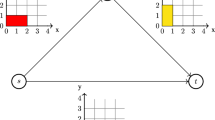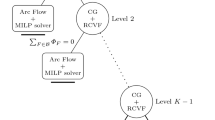Abstract
The following problem arises in the study of lightwave networks. Given a demand matrix containing amounts to be routed between corresponding nodes, we wish to design a network with certain topological features, and in this network, route all the demands, so that the maximum load (total flow) on any edge is minimized. As we show, even small instances of this combined design/routing problem are extremely intractable. We describe computational experience with a cutting plane algorithm for this problem.
Similar content being viewed by others
References
A. Balakrishnan, T.L. Magnanti and R. Wong, “A dual-ascent procedure for large-scale uncapacitated network design,”Operations Research 37 (1989) 716–740.
S. Ceria, personal communication.
S. Chopra, “Polyhedra of the equivalent subgraph and some edge connectivity problems,”SIAM Journal on Discrete Mathematics 5 (1992) 321–337.
W. Cook, personal communication.
M.D. Grigoriadis and L.G. Khachiyan, “Fast approximation schemes for convex programs with many blocks and coupling constrains,” Report DCS-TR-273, Department of Computer Science, Rutgers University (1991).
M. Grötschel and C.L. Monma, “Integer polyhedra associated with certain network design problems with connectivity constraints,”SIAM Journal on Discrete Mathematics 3 (1990) 502–523.
O. Günlük, “Combinatorial optimization problems in lightwave networks,” Ph.D. Thesis, Department of IEOR, Columbia University (1993).
J.-F. Labourdette, “Rearrangeability techniques for multihop lightwave networks and application to distributed ATM switching systems,” Tech. Report CU/CTR/TR 244-91-25, Center for Telecommunications Research, Columbia University (1991).
J.-F. Labourdette and A. Acampora, “Partially reconfigurable multihop lightwave networks,”IEEE Transactions on Communication 39 (1991) 1223–1230.
F.T. Leighton, F. Makedon, S. Plotkin, C. Stein, E. Tardos and S. Tragoudas, “Fast approximation algorithms for multicommodity flow problems,” in:Proceedings 23rd ACM Symposium on Theory of Computing (May 1991) 101–111.
T. Leong, P. Shor and C. Stein, “Implementation of a combinatorial multicommodity flow algorithms,” in:Proceedings DIMACS Implementation Challenge Workshop: Network Flows and Matching (October 1991).
I. Lustig, personal communication.
G.L. Nemhauser and L.A. Wolsey,Integer and Combinatorial Optimization (Wiley, New York, 1988).
M.W. Padberg, T.J. Van Roy and L.A. Wolsey, “Valid linear inequalities for fixed charge problems,”Operations Research 33 (1985) 842–861.
R.L. Rardin and L.A. Wolsey, “Valid inequalities and projecting the multicommodity extended formulation for uncapacitated fixed charge network network flow problems,” manuscript (1991).
F. Shahrokhi and D.W. Matula, “The maximum concurrent flow problem,”Journal of the ACM 37 (1990) 318–334.
T.J. Van Roy and L.A. Wolsey, “Valid inequalities and separation for uncapacitated fixed charge networks,”Operations Research Letters 4 (1985) 105–112.
Author information
Authors and Affiliations
Additional information
This research was partially supported by a Presidential Young Investigator Award and the Center for Telecommunications Research, Columbia University.
Corresponding author.
Rights and permissions
About this article
Cite this article
Bienstock, D., Günlük, O. Computational experience with a difficult mixedinteger multicommodity flow problem. Mathematical Programming 68, 213–237 (1995). https://doi.org/10.1007/BF01585766
Received:
Revised:
Issue Date:
DOI: https://doi.org/10.1007/BF01585766




